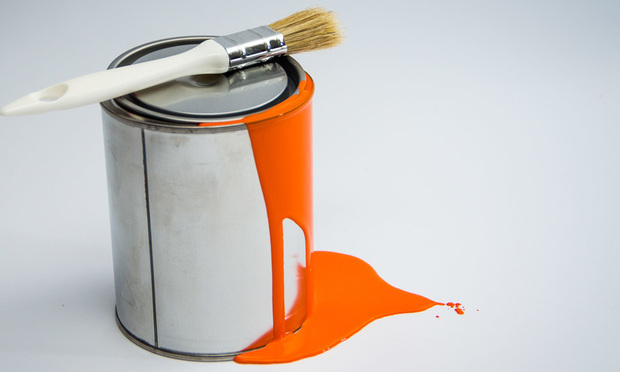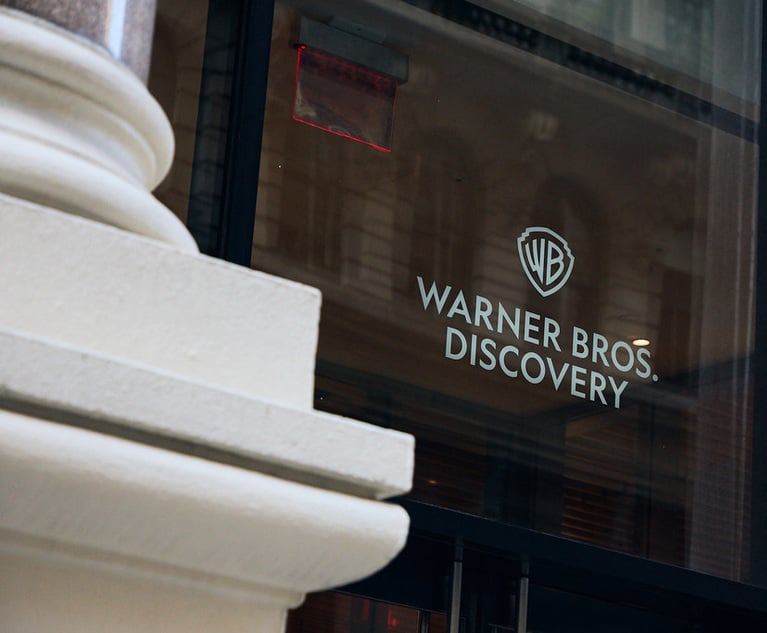Landmark Lead Paint Liability Ruling Faces Rare Ballot-Box Resistance
Conagra Grocery Products Co., NL Industries Inc. and The Sherwin-Williams Co. are pushing to qualify a November ballot initiative that would eliminate their court-determined liability to remediate lead paint contamination.
May 03, 2018 at 06:56 PM
4 minute read
The original version of this story was published on The Recorder

State lawmakers are pushing back on three paint manufacturers' unusual attempt to circumvent a $1.1 billion verdict holding them liable for exposing customers to lead in their products.
Conagra Grocery Products Co., NL Industries Inc. and The Sherwin-Williams Co. are pushing to qualify a November ballot initiative that would eliminate their court-determined liability to remediate lead paint contamination, according to an analysis by the attorney general's office. Instead, the measure would authorize a $2 billion state bond sale to pay for abatement work.
In pursuit of qualifying that initiative, the paint companies have created a website, notanuisance.com, that claims “millions of California homes” could be “red tagged” because of the Sixth District Court of Appeal's November 2017 ruling. The site allows visitors to send pre-written emails to legislators, pleading them to overturn the court's lead-paint ruling.
On Wednesday, eight state lawmakers urged executives of the paint companies to take down the website and its “factually dubious claims.”
“You falsely claim that the court decision 'red tags' millions of millions of California homes and labels them a nuisance,” the legislators said in a letter. “The judges specifically rebutted your false assertion that the 'court's abatement order has “declared a nuisance” on individual properties without notice to the property owners.' Your claim has no basis in fact.”
The backers of the initiative say the site's assertions are valid and that houses and apartments publicly identified for remedial work will lose value.
“I strongly disagree with the tone of the letter and the allegations that these companies have somehow lied or tried to deceive anyone in the state,” said Jones Day partner Antonio “Tony” Dias, a lawyer for Sherwin-Williams.
A three-justice state appellate panel held last year that the paint-makers “must have known from the early 20th century” that interior lead paint posed a serious harm to children. Although ruling for the plaintiffs—10 cities and counties—the justices did send the case back to the trial court to recalculate what was a $1.15 billion judgment against the companies handed down in 2014.
The California Supreme Court in February declined to review the decision. Dias said the defendants are preparing to petition the U.S. Supreme Court to hear the case.
The time it has taken for the case to reach a final determination has allowed the paint companies to pursue their ballot initiative and subsequent campaign, said San Francisco attorney Mary Alexander, who served as co-lead counsel for the plaintiffs.
“It's unprecedented to have defendants try to undo what the courts have decided and to try to shirk their responsibilities under the law by filing an initiative,” Alexander said in a press call Thursday with Assemblyman David Chiu, D-San Francisco.
Chiu and five other legislative Democrats have introduced bills related to the lead paint ruling. Chiu's bill, AB 2073, would shield homeowners who participate in abatement programs from being sued by paint manufacturers for comparative fault—a possibility raised by the Sixth District panel in its ruling.
While the paint companies' initiative campaign is a rare tactic, it's not unusual for losing parties in lawsuits to take their grievances to other branches of government.
Container manufacturer Crown Cork and Seal has pursued legislation in several states to shield itself from successor mesothelioma claims stemming from its 1963 merger with a company that made asbestos-containing insulation.
The three paint company-defendants in the lead paint case have each loaned $2 million to the campaign committee formed to quality the ballot initiative.
Read more:
California Supreme Court Allows Landmark Lead Paint Ruling to Stand—for Now
Lead Paint Defendants Seek to Upend $1B Public-Nuisance Finding
Lead Paint Makers Liable for Public Nuisance, Appeals Panel Rules
This content has been archived. It is available through our partners, LexisNexis® and Bloomberg Law.
To view this content, please continue to their sites.
Not a Lexis Subscriber?
Subscribe Now
Not a Bloomberg Law Subscriber?
Subscribe Now
NOT FOR REPRINT
© 2025 ALM Global, LLC, All Rights Reserved. Request academic re-use from www.copyright.com. All other uses, submit a request to [email protected]. For more information visit Asset & Logo Licensing.
You Might Like
View All
COVID-19 Vaccine Suit Against United Airlines Hangs on Right-to-Sue Letter Date
3 minute read
Lavish 'Lies' Led to Investors Being Fleeced in Nine-Figure International Crypto Scam
3 minute read
Trending Stories
- 1Attorney Sanctioned $9K for Revealing Nude Photos, Other Info in Court Filing
- 2Shifting Battlegrounds in Administrative Law, From Biden to Trump II
- 3Bar Report - Jan. 13
- 4Newsmakers: Robert Collins, Barron Wallace Elected to Bracewell’s Management Committee
- 5Navigating the Shifting Sands of E-Discovery and Information Governance in 2025
Who Got The Work
Michael G. Bongiorno, Andrew Scott Dulberg and Elizabeth E. Driscoll from Wilmer Cutler Pickering Hale and Dorr have stepped in to represent Symbotic Inc., an A.I.-enabled technology platform that focuses on increasing supply chain efficiency, and other defendants in a pending shareholder derivative lawsuit. The case, filed Oct. 2 in Massachusetts District Court by the Brown Law Firm on behalf of Stephen Austen, accuses certain officers and directors of misleading investors in regard to Symbotic's potential for margin growth by failing to disclose that the company was not equipped to timely deploy its systems or manage expenses through project delays. The case, assigned to U.S. District Judge Nathaniel M. Gorton, is 1:24-cv-12522, Austen v. Cohen et al.
Who Got The Work
Edmund Polubinski and Marie Killmond of Davis Polk & Wardwell have entered appearances for data platform software development company MongoDB and other defendants in a pending shareholder derivative lawsuit. The action, filed Oct. 7 in New York Southern District Court by the Brown Law Firm, accuses the company's directors and/or officers of falsely expressing confidence in the company’s restructuring of its sales incentive plan and downplaying the severity of decreases in its upfront commitments. The case is 1:24-cv-07594, Roy v. Ittycheria et al.
Who Got The Work
Amy O. Bruchs and Kurt F. Ellison of Michael Best & Friedrich have entered appearances for Epic Systems Corp. in a pending employment discrimination lawsuit. The suit was filed Sept. 7 in Wisconsin Western District Court by Levine Eisberner LLC and Siri & Glimstad on behalf of a project manager who claims that he was wrongfully terminated after applying for a religious exemption to the defendant's COVID-19 vaccine mandate. The case, assigned to U.S. Magistrate Judge Anita Marie Boor, is 3:24-cv-00630, Secker, Nathan v. Epic Systems Corporation.
Who Got The Work
David X. Sullivan, Thomas J. Finn and Gregory A. Hall from McCarter & English have entered appearances for Sunrun Installation Services in a pending civil rights lawsuit. The complaint was filed Sept. 4 in Connecticut District Court by attorney Robert M. Berke on behalf of former employee George Edward Steins, who was arrested and charged with employing an unregistered home improvement salesperson. The complaint alleges that had Sunrun informed the Connecticut Department of Consumer Protection that the plaintiff's employment had ended in 2017 and that he no longer held Sunrun's home improvement contractor license, he would not have been hit with charges, which were dismissed in May 2024. The case, assigned to U.S. District Judge Jeffrey A. Meyer, is 3:24-cv-01423, Steins v. Sunrun, Inc. et al.
Who Got The Work
Greenberg Traurig shareholder Joshua L. Raskin has entered an appearance for boohoo.com UK Ltd. in a pending patent infringement lawsuit. The suit, filed Sept. 3 in Texas Eastern District Court by Rozier Hardt McDonough on behalf of Alto Dynamics, asserts five patents related to an online shopping platform. The case, assigned to U.S. District Judge Rodney Gilstrap, is 2:24-cv-00719, Alto Dynamics, LLC v. boohoo.com UK Limited.
Featured Firms
Law Offices of Gary Martin Hays & Associates, P.C.
(470) 294-1674
Law Offices of Mark E. Salomone
(857) 444-6468
Smith & Hassler
(713) 739-1250









